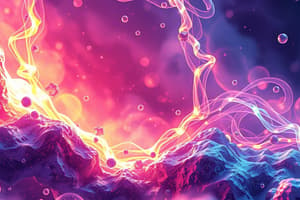Podcast
Questions and Answers
What does thermodynamics primarily focus on in physical chemistry?
What does thermodynamics primarily focus on in physical chemistry?
- The identification of substances using electromagnetic radiation
- Energy and heat transfer (correct)
- The behavior of matter at a microscopic level
- The rates of chemical reactions
Which principle explains how systems at equilibrium respond to changes?
Which principle explains how systems at equilibrium respond to changes?
- Enthalpy changes
- Gibbs free energy
- Le Chatelier's principle (correct)
- Rate laws
What is primarily studied in kinetics within the realm of physical chemistry?
What is primarily studied in kinetics within the realm of physical chemistry?
- The synthesis of solid phase materials
- The electron distribution in atoms
- Reaction rates and the factors affecting them (correct)
- The organization of elements in the periodic table
Which of the following concepts is most related to quantum chemistry?
Which of the following concepts is most related to quantum chemistry?
Which block of the periodic table contains main group elements?
Which block of the periodic table contains main group elements?
What aspect of coordination chemistry involves studying metal ions and ligands?
What aspect of coordination chemistry involves studying metal ions and ligands?
What characterizes transition metals in inorganic chemistry?
What characterizes transition metals in inorganic chemistry?
Which type of spectroscopy is commonly used to identify substances through their interaction with infrared radiation?
Which type of spectroscopy is commonly used to identify substances through their interaction with infrared radiation?
What does the study of solid state chemistry primarily involve?
What does the study of solid state chemistry primarily involve?
How does the periodic table organize elements?
How does the periodic table organize elements?
Flashcards are hidden until you start studying
Study Notes
Physical Chemistry
-
Definition: Study of how matter behaves on a molecular and atomic level and how chemical reactions occur.
-
Key Concepts:
- Thermodynamics:
- Laws governing energy and heat transfer.
- Key principles: Internal energy, enthalpy, entropy, and Gibbs free energy.
- Kinetics:
- Study of reaction rates and the factors affecting them.
- Concepts include rate laws, activation energy, and reaction mechanisms.
- Equilibrium:
- State where reactants and products' concentrations remain constant over time.
- Le Chatelier's principle describes how a system at equilibrium responds to changes.
- Quantum Chemistry:
- Application of quantum mechanics to chemical systems.
- Understands electron distribution and behavior in atoms and molecules.
- Spectroscopy:
- Techniques used to identify substances based on their interaction with electromagnetic radiation (e.g., UV-Vis, IR, NMR).
- Thermodynamics:
Inorganic Chemistry
-
Definition: Study of inorganic compounds, typically those that are not based on carbon-hydrogen bonds.
-
Key Concepts:
- Periodic Table:
- Organization of elements based on atomic number, electron configuration, and recurring chemical properties.
- Groups and periods indicate similar properties and trends (e.g., electronegativity, ionization energy).
- Coordination Chemistry:
- Study of coordination compounds, formed between metal ions and ligands.
- Includes understanding of coordination number, geometry, and isomerism.
- Solid State Chemistry:
- Focus on the synthesis, structure, and properties of solid phase materials.
- Concepts include crystal lattice structures, defects, and phase transitions.
- Main Group Elements:
- Elements found in the s and p blocks of the periodic table.
- Characteristic reactions and compounds (e.g., alkali metals, halogens).
- Transition Metals:
- Elements in the d block with unique properties such as variable oxidation states and colored compounds.
- Importance in catalysis and complex formation.
- Periodic Table:
Physical Chemistry
- Study of matter behavior at molecular and atomic levels, focusing on chemical reactions.
- Thermodynamics: Governs energy and heat transfer; key concepts include:
- Internal Energy: Total energy within a system.
- Enthalpy: Heat content associated with a chemical reaction.
- Entropy: Measure of disorder or randomness within a system.
- Gibbs Free Energy: Determines spontaneity of reactions.
- Kinetics: Analyzes reaction rates and influencing factors such as:
- Rate Laws: Mathematical expressions relating reaction rate to reactant concentrations.
- Activation Energy: Minimum energy required for a reaction to occur.
- Reaction Mechanisms: Sequence of steps that lead to product formation.
- Equilibrium: Condition where concentrations of reactants and products remain unchanged over time.
- Le Chatelier's Principle: Describes system responses to disturbances (e.g., changes in concentration, temperature).
- Quantum Chemistry: Merges quantum mechanics with chemical systems, focusing on:
- Electron distribution and behavior in atoms and molecules.
- Spectroscopy: Analytical techniques that identify substances via interaction with electromagnetic radiation, including:
- UV-Vis: Ultraviolet-visible spectroscopy.
- IR: Infrared spectroscopy.
- NMR: Nuclear magnetic resonance spectroscopy.
Inorganic Chemistry
- Focus on inorganic compounds, primarily those lacking carbon-hydrogen bonds.
- Periodic Table: Elements arranged by atomic number and electron configuration, highlighting:
- Groups and Periods: Indicate elements with similar properties; trends observed include electronegativity and ionization energy.
- Coordination Chemistry: Examines coordination compounds formed from metal ions and ligands, covering:
- Coordination Number: Number of ligand attachments to the central metal ion.
- Geometry: Spatial arrangement of ligands around the metal.
- Isomerism: Different compounds with the same formula but distinct arrangements.
- Solid State Chemistry: Studies synthesis, structure, and properties of solid materials, including:
- Crystal Lattice Structures: Ordered arrangement of atoms in solids.
- Defects: Irregularities in crystal structures affecting material properties.
- Phase Transitions: Changes between different states of matter (e.g., solid to liquid).
- Main Group Elements: Elements in the s and p blocks with notable characteristics in reactions and compounds.
- Transition Metals: Elements in the d block, noteworthy for:
- Variable oxidation states and the formation of colored compounds.
- Significant roles in catalysis and complex formation.
Studying That Suits You
Use AI to generate personalized quizzes and flashcards to suit your learning preferences.




